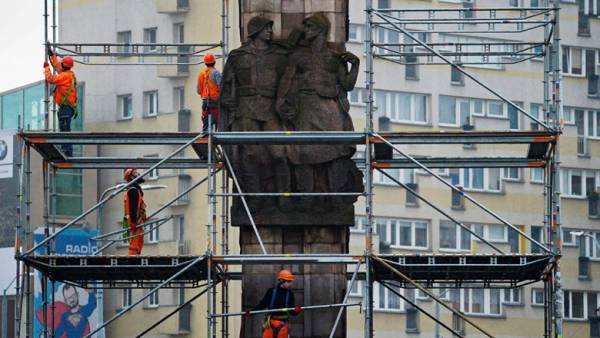Monumento Mori
“B” got a list of monuments to Soviet soldiers who are going to carry in Poland.

As it became known “Kommersant”, this year the Polish Institute of national remembrance has recommended to local authorities to demolish 75 monuments to soldiers of the red army, the Soviet partisans and prisoners of war. The list of monuments that are to be removed, is at the disposal of the newspaper (see “Kommersant”). The correspondent of “Kommersant” Galina Dudina has reviewed this list and visited Warsaw, Gdansk, Elblag, Braniewo and Olsztynek to see how the poles take care of those monuments that demolition cannot be considered. In any case, for now.
“For so many years is — albeit much more worth it”
“The battles for the liberation of Warsaw has killed thousands of Soviet soldiers. How to destroy the monuments which they raised?” — 82-year-old Wieslaw sitting on a bench on the main Avenue of Warsaw Skaryszewski Park and nods to the monument of gratitude to soldiers of the red army.
I was born in Warsaw, during the war I was taken to relatives, but the father and mother were in the camp, and mother was liberated by Soviet soldiers.
On a hot summer day in this Park is crowded. On 55 hectares it would be easy to get lost, if not for reference points — a dozen of sculptures and monuments. The poles killed in the terrorist attack of 11 September 2001 in new York and the heroes of world war II. The monument of gratitude — the largest and best known over the last ten years, the media have repeatedly reported the desecration, when the Polish nationalists were painted and filled the monument with paint.
Scarlet spots are now filled, but still Shine and look creepy. Memorial plaque (“Eternal glory to the heroes of the red army who fell in battles for the liberation of the Polish capital of Warsaw”) is fractured, the Sandstone in places, blackened by time.
As reported in late June the city authorities, as soon as the Museum of the history of Poland will agree to accept a monument in the vaults, it can be disassembled in accordance with the law banning the promotion of communism. Formal barriers to this is no: when the memorial was a mass grave, but the remains have been exhumed and moved to a “normal” cemetery. The monument itself had to move, and now completely ready to remove from the Park.
However, to find among strolling through the Park people, though one fierce opponent of the monument was not so easy — but unlike Wisława most of my interlocutors are quite indifferent. “I live nearby and I see that the monuments are destroyed, says 31-year-old Camille.— So I don’t know, maybe they can somehow save, to create a Museum and put them there?” “In our family I respect all the monuments — and then he put in the place of death of the soldiers”, adds the 50-year-old Zofia. “For so many years is — albeit much more worth it,” says 31-year-old Carolina, who came to the Park with two children.
In the war many of the burial of the dead in Poland, the red army soldiers were taken where necessary — including parks, squares, junctions. In the postwar years, throughout the country carried out the exhumation and reburial of the remains at the military cemetery. Parallel to the established monuments of gratitude to Soviet soldiers, prisoners of war, Polish-Soviet brotherhood in arms.